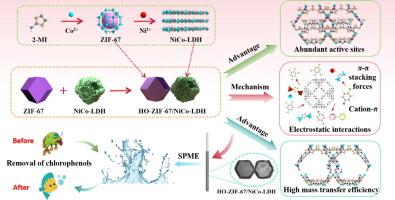Twin HO-ZIF-67/NiCo-LDH with hollow structure as a novel coating for solid-phase microextraction of chlorophenols with boosting performance
IF 13.3
1区 工程技术
Q1 ENGINEERING, CHEMICAL
引用次数: 0
Abstract
Chlorophenols (CPs) are recognized persistent toxic pollutants (PTPs) that pose a significant risk to both the health of the environment and human beings due to their cancer-inducing properties and the presence of fertility-impairing properties. For the sake of detect and adsorb CPs, in this paper, a twin hollow composite (HO-ZIF-67/NiCo-LDH) derived from metal-organic frameworks (MOFs) and layered double hydroxides (NiCo-LDH) were designed and synthesized by simple combining the two dopants and carbonization, it had both high adsorption capacity and shortened adsorption equilibrium time. Using HO-ZIF-67/NiCo-LDH as a coating, a solid-phase microextraction (SPME) combining with high-performance liquid chromatography (HPLC) method was prepared to boosting extract CPs from complex matrices. Notably, with the optimal extraction conditions of orthogonal array design (OAD), the method provided a low detection limit (0.005–––0.264 μg·L-1), a wide linear range (0.018–––1000.0 μg·L-1), a favorable reproducibility, and an excellent performance in comparison with other materials as evaluated by thermodynamic and kinetic methods for adsorption performance (82.95–––22.50mg g−1) and adsorption equilibrium time (20 min). This experiment provided a simple strategically sound approach for the synthesis of twin hollow MOFs adsorbents and explored the process of hollow structure formation. It realizes a new approach to adsorption and detection of organic pollutants by highlighting the advantages of two different materials and applying them in combination.


具有中空结构的双HO-ZIF-67/NiCo-LDH作为新型涂层用于提高氯酚的固相微萃取性能
氯苯酚(CPs)是公认的持久性有毒污染物(PTPs),由于其致癌和影响生育的特性,对环境和人类健康都构成了重大威胁。为了检测和吸附氯化石蜡,本文设计并通过简单的两种掺杂剂的结合和碳化合成了一种由金属有机框架(MOFs)和层状双氢氧化物(NiCo-LDH)衍生的双中空复合材料(HO-ZIF-67/NiCo-LDH),它既具有高吸附容量,又缩短了吸附平衡时间。以HO-ZIF-67/NiCo-LDH为涂层,制备了一种固相微萃取(SPME)与高效液相色谱(HPLC)相结合的方法,以提高从复杂基质中萃取氯化石蜡的能力。通过热力学和动力学方法对吸附性能(82.95--22.50mg g-1)和吸附平衡时间(20 min)的评估,该方法在正交阵列设计(OAD)的最佳萃取条件下,检出限低(0.005--0.264 μg-L-1),线性范围宽(0.018--1000.0 μg-L-1),重现性好,与其他材料相比性能优异。该实验为孪晶中空MOFs吸附剂的合成提供了一种策略上简便可行的方法,并探索了中空结构的形成过程。它通过突出两种不同材料的优势并将其结合应用,实现了一种吸附和检测有机污染物的新方法。
本文章由计算机程序翻译,如有差异,请以英文原文为准。
求助全文
约1分钟内获得全文
求助全文
来源期刊

Chemical Engineering Journal
工程技术-工程:化工
CiteScore
21.70
自引率
9.30%
发文量
6781
审稿时长
2.4 months
期刊介绍:
The Chemical Engineering Journal is an international research journal that invites contributions of original and novel fundamental research. It aims to provide an international platform for presenting original fundamental research, interpretative reviews, and discussions on new developments in chemical engineering. The journal welcomes papers that describe novel theory and its practical application, as well as those that demonstrate the transfer of techniques from other disciplines. It also welcomes reports on carefully conducted experimental work that is soundly interpreted. The main focus of the journal is on original and rigorous research results that have broad significance. The Catalysis section within the Chemical Engineering Journal focuses specifically on Experimental and Theoretical studies in the fields of heterogeneous catalysis, molecular catalysis, and biocatalysis. These studies have industrial impact on various sectors such as chemicals, energy, materials, foods, healthcare, and environmental protection.
 求助内容:
求助内容: 应助结果提醒方式:
应助结果提醒方式:


